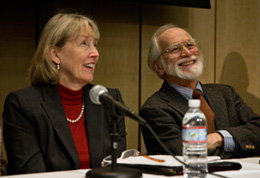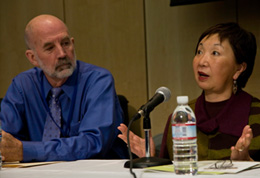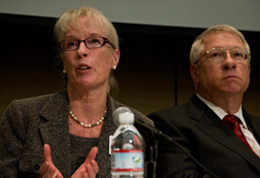UCSF Leaders Gather to Present Results, Examine Challenges in Nurturing Diversity

Patricia Calarco, dean of the UCSF Graduate Division, and Chancellor Mike Bishop participated in the recent panel discussion on diversity at UCSF.
By Shipra Shukla

Patricia Calarco, dean of the UCSF Graduate Division, and Chancellor Mike Bishop participated in the recent panel discussion on diversity at UCSF.
Campus leaders recently reported on progress made over the previous year in creating a more diverse campus community, addressed gaps and shared plans for the road ahead.
Chancellor Mike Bishop, MD, opened the event with an introduction about the importance of diversity and measuring results. “I heard someone once say, ‘In God we trust; everyone else needs to present data,’” said Bishop.
The audience laughed as they settled in for the two-hour event that focused very seriously on analyzing the quantitative and qualitative data to determine how UCSF can further its goal of nurturing diversity, one of seven strategic priorities outlined in the UCSF Strategic Plan.
Among the accomplishments in diversity that Eugene Washington, MD, executive vice chancellor and provost, pointed out were implementing a campuswide communications initiative, establishing a database for conducting faculty searches and incorporating recommendations from the strategic plan as they relate to serving the local and global communities. Plans for the year ahead include strengthening accountability from leadership and enhancing coordination among academic outreach programs, he said.
While there have been major strides in increasing the number of underrepresented graduate students admitted to UCSF – which can, in part, be attributed to more scholarship funding and academic outreach programs – this progress has not yet been seen at the faculty and staff levels, campus leaders say.
For her part, Renee Navarro, MD, PharmD, director of academic diversity, presented data that show UCSF has gained 169 faculty members in the last three years.
“Within that time, the presence of women faculty has increased from 41 percent to 43 percent of our faculty,” Navarro said. “Asian faculty have increased from 19 to 20 percent of the faculty. Those groups that have been historically underrepresented, however, remain at 2 percent for African American faculty, 3 percent for Hispanic faculty and less than 1 percent for American Indians.”

Mary Anne Koda-Kimble, dean of the UCSF School of Pharmacy, makes a point while John Featherstone, dean of the UCSF School of Dentistry, listens.
Federal affirmative action regulations require each campus to produce annual statistical reports comparing the percentage of women and minority faculty in each academic job group with the availability percentage. When a discrepancy is identified, UCSF has an obligation to develop annual recruitment goals.
“We have instituted the academic demographic system as a part of our efforts to provide more clarity and transparency to the academic recruitment process,” Navarro said.
“This system allows quarterly assessment of departments’ demographics and provides national availability data for faculty searches, so we can assess if our applicant pool matches what is available. Our office is able to intervene and provide additional resources for candidate searches.”
Need for Visibility
“Diversity must be visible,” said Samuel Hawgood, MB, BS, interim dean of the UCSF School of Medicine. “The fact that there are so many leaders here in the room today shows that our commitment to excellence is directly linked to our commitment to diversity, and those two things cannot, and will not, be separated.”
In the medical school, 28 percent of students are underrepresented minorities or are African American, Hispanic/Latino or American Indian/Alaskan Native. That’s down slightly from 35 percent in 2007 and the same as in 2006. In 2005, 17 percent of the medical students were from underrepresented groups.
The steps needed to promote diversity within the School of Medicine are seen as the same steps that need to be taken to promote excellence within the school, he noted.
Hawgood pointed to targeted academic outreach efforts as one such step. He attributed some of the gains achieved in diversity among residents and trainees to UCSF’s increased visibility at national conferences like the National Hispanic Medical Association meeting. These efforts were overseen by Bobby Baron, MD, associate dean for graduate medical education and Rene Salazar, MD, coordinator for graduate medical education.
While UCSF leaders recognize that diversity and excellence are connected to visibility, Hawgood noted that UCSF still has a long way to go to achieve diversity among the faculty ranks.
In the medical school, less than 6 percent of the faculty are underrepresented minorities.
Hawgood did point out that over the past several years, the number of department chairs, directors and division chiefs from underrepresented groups has grown. “Nurturing diversity is not an end in itself, but a means that we aspire to, which is excellence,” said Hawgood.
Change Is Slow
UCSF still lacks diversity at the leadership level, and most underrepresented staff members remain clustered in lower-paid positions across the University.
“We’re treading water; we’re a bit stalled,” said Steve Barclay, senior vice chancellor of Resource Management and Capital Programs. “However, I think we do have the opportunity to make headway in the future.”
Barclay analyzed and presented more than two years of data that had been compiled under the leadership of Michael Adams, director of Affirmative Action, Equal Opportunity and Diversity.
“We see that there hasn’t been much change in the past two years on much of the staff side,” said Barclay. “UCSF staff is still comprised mainly of women who are white. As we move up the staff ranks and into the dean level, we see that changes to mainly male and white.”

Kathleen Dracup, dean of the UCSF School of Nursing, talks about progress nurturing diversity while Ken Jones, acting chief operating officer of UCSF Medical Center, looks on.
Barclay pointed out that diversity does exist at UCSF. The key, however, is to retain it and develop it. “In order to see systemic change in the workforce, especially at the top level, we need to nurture and grow our own,” he said. “As the data shows, the diversity is here already. We now need to develop those individuals.”
UCSF has begun offering managers and department heads training programs to develop leadership skills as a way to promote from within the University. In addition, supervisors will begin a training program designed to foster understanding of the many aspects of diversity – including sexual orientation and disability status.
Barclay noted that all of the steps being taken to increase diversity, such as pipeline initiatives and mentoring, are aligned with the UCSF Strategic Plan. The idea is to measure how the steps to diversity are being measured against the goals in the strategic plan.
The large turnout at the event and interest in viewing the data further indicate that the campus community has a vested interest in diversity.
During the panel question-and-answer session, an audience member referenced UCSF’s mission of advancing health worldwide and asked, “Does UCSF’s diversity initiative include efforts to bring in perspectives from the international arena through institutional collaborations outside the US?”
Nearly all the leaders took the time to address the question as it related to their professional school.
“We have partnerships around the globe, much of it through Global Health Sciences, that are meaningful, intense partnerships in research, education and providing health care,” said Washington. “This is part of the diversity we seek to nurture, and we recognize the importance of these partnerships.”
The questions about the data presented and directions the University is taking continued well past the end of the session. Many of the questions touched on the idea of diversity’s survival during a tough economic climate.
“This is really about our core value; that’s why we are here,” said Mary Anne Koda-Kimble, PharmD, dean of the School of Pharmacy. “We can do this in the worst of economic times. Money is not an excuse. It’s about creating a climate that nurtures diversity.”
Photos by Susan Merrell
Related Link:
Powerpoints:
- Graduate Division: 20+ Years of Diversity Initiatives and Progress
- Overview and Academic Diversity
- School of Medicine
- Staff
- Ten Point Diversity Plan
Photo by Susan Merrell